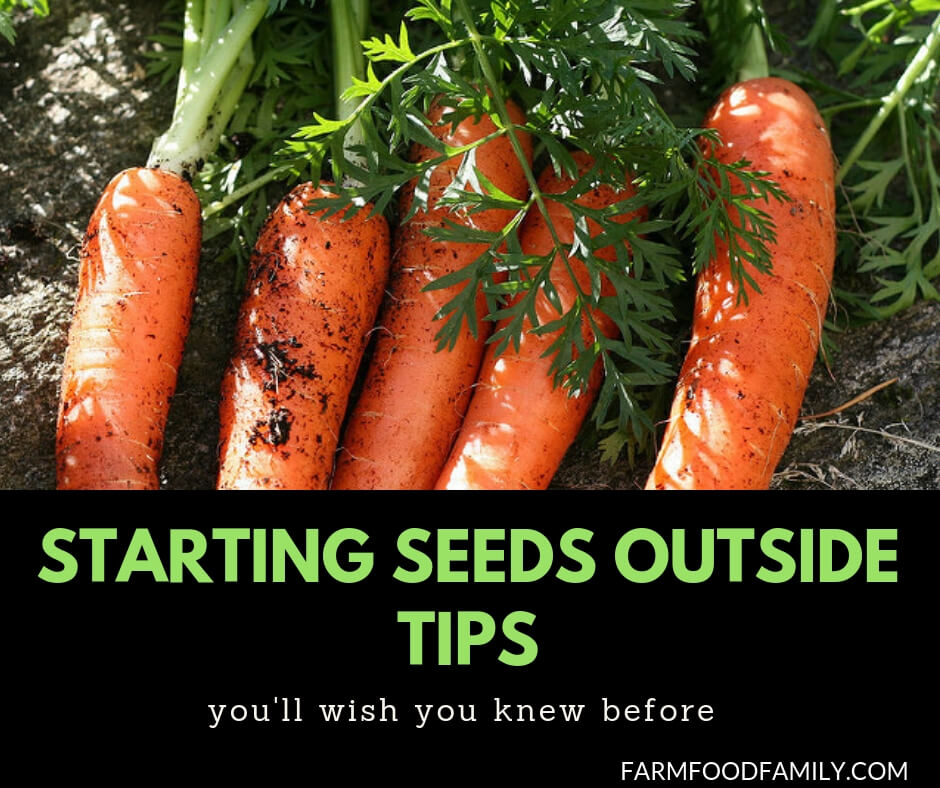While many plants need to be germinated from seed well before the garden season starts, starting seeds direct in the garden is actually the preferred method for quite a number of edible garden crops. Knowing which seeds and why really helps.
Which vegetable garden seeds can be started outdoors? And why would starting some seeds outdoors and others indoors make such a difference? Read on…

1. Who HAS to start inside?

Nobody, really, but… Are You Racing the Seasons?
Many items started inside need a long season to go OR people like them too much to wait for “from scratch” harvest times. Tomatos, peppers, eggplants, and basil are too good to wait for, AND they are sturdy enough to handle some manhandling.
Brussels sprouts and artichokes have very long, slow seasons, so getting a jump on them is just to beat next winter’s start.
And sometimes the garden is just crowded. At the height of the growing seasons, it can be easier to take over the side of the dining room than to find a patch of open ground in the garden. So do you HAVE to start your fall greens inside? No. But it can save some bickering.
2. Which Garden Vegetables Can’t Be Transplanted?
The Delicate Stemmed
Some plants are too fragile to start in pots- they’ll never or rarely survive a transplanting. In this Direct Sow Only category are things like pole beans and peas, and those give a good hint: thin vines are unlikely candidates for a head start.
The Truly Rooty
The corollary to be tender up top: most root vegetable crops just really hate you for doing anything other than gently adding dirt from time to time in the season. (And not even all of them like that.)
Carrots and beets dislike being transplanted. You’d think “but they are so big and sturdy” but no. They are a web of the tiniest threads of roots all eminanting from what will become (but is not yet) the honker tubers and taproots we know and love.
But Don’t I Start My Potatoes From Sets?
Crucial difference! Picture the carrot growing: one big tap root, little lacey root webs radiating out from there.
Now picture the potato growing: a snarl of fat roots interrupted here and there by these tuberous swellings. This is not the organized solar system of the carrot, this is more like a garden’s answer to the astroid belt. Potatos can really get going, with long intimidating roots and stems, before you get around to planting them in the garden. Once they are in, however, just heap. Don’t dig.
3. Pushing Your Luck: Starting Seeds in the Snow

Spring is antsy and capricious. Many backyard gardeners are antsy and optimistic. It seems a shame to realize it’s already been warm a month and you’ve missed that precious edge of the season.
Spinach and many lettuces handle cold well, even when they are quite young. Many gardeners take advantage of this by by starting them early inside in order to have healthy little youngsters to pop into the ground as soon as it warms up enough to work (and not be a heavy sodden mess).
But do you have to? No. How precious is your seed supply? Are you risking your whole crop for the year or can you afford to start over if Old Man Winter rolls back in to town?
Seasons extending options abound! In the backyard, this is where cold frames come in handy. Just be sure to open the lid during the day! You are in more danger of cooking your freshly germinated seedlings by day than of freezing them by night.
4. Act Natural: How to Beat the Odds

So you’ve decided to go for it: starting seeds by sowing them directly into the garden bed. How?
You need a sunny day.
You need open ground that is not frozen. Two sunny days coming? Clear the ground, laydown blackplastic or an old window for the first day. That’ll heat up the soil in that little spot a bit further. One sunny day? Jump straight to clearing the debris and scratching up the surface a bit.
You need water. Most seeds are fairly dry and need to rehydrate to get the metabolic processes going. You do not, however, need a raft of water if the snow has just melted off.
Remember: nobody (but the evergreen tree) is awake, so nobody is breathing all that moisture back into the air. Water doesn’t move that fast in winter, so you need some, and you’ll need some more tomorrow, but you don’t need twelve beach buckets worth.
You need poles (or branches or wire frame or honestly even chopsticks will work, though you’ll need more of them) and
You need old sheets and blankets.
You need access to the weather forecast. Be aware of when the late frosts are coming. Stab the sticks into the ground near but not on top of where you planted, and drape the sheets and blankets to create a little tent over the seedlings on when it’s going to dip below freezing. Try not to have the cloth actually touch the plants.
and maybe a pack of sticky notes. Leave your self notes around the house: “Uncover the garden before work!” “Frost coming Thursday.” “Nothing (ad)ventured, nothing gained.” And maybe, in the bottom of your big snow boots: “Try again! You can do this!”


